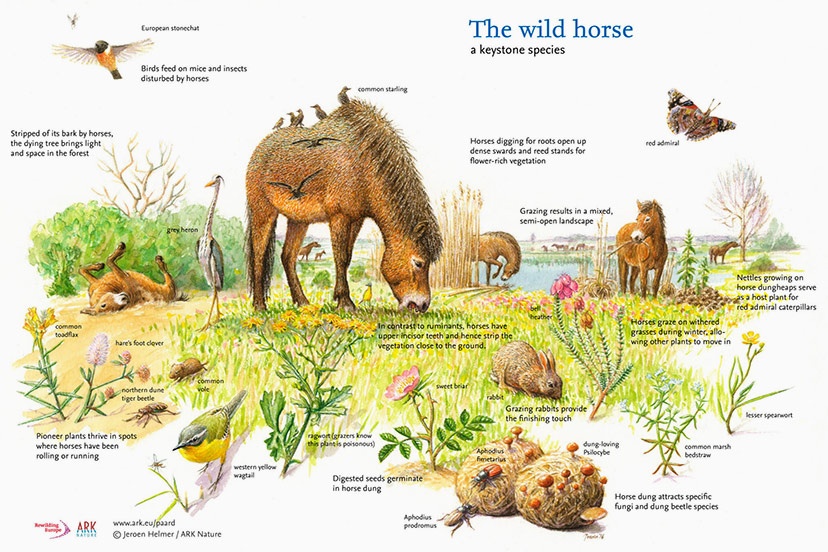Greetings fellow scientists:
RE: Your announcement herein below…
“The California Wool Growers Association (CWGA) and UC Cooperative Extension (UCCE) are collaborating to organize an afternoon seminar on a variety of targeted grazing topics at this year’s CWGA Annual Convention in Minden, NV, on Friday, August 19, 2022.”
…I offer the following…
It seems obvious when stated, that ‘not all herbivores are created equal’, but in practice over the past decades, that observation has been clearly misplaced in practice due to outdated science, dogma, economic and political pressures.
It is critical for maintaining sustainable western landscapes (especially public lands) that range-land managers evolve thinking past the 19th century science and even myths that still prevail among some academics in regard to incorrectly demonizing equids (wild horses).
Wild horses are critically important keystone herbivores on the North American landscape as the only large-bodied native herbivore that reseeds wilderness landscapes and maintains the life-cycles of co-evolved native plants and grasses, which in turn supports the life-cycles of co-evolved fauna that depend upon native flora for their survival.
Invasive species livestock (cattle, sheep and goats) that evolved off-continent (Africa), which published studies show, digest virtually all the seeds of North American plants and grasses, ultimately strip-off native cover crops, enhancing soil erosion, thereby adversely impacting refreshment of aquifers via precipitation, as well as resulting-in the excessive erosion and silting-in of spawning grounds for trout and salmon.
In studying the digestive systems of ruminant invasive species livestock as compared to the simple digestive system of E. Caballus (horses), an evolved N. American species, we find an important and significant difference, that is quite meaningful for sustainable land management and targeting and selecting grazing herbivores for specific areas.
My thesis in brief, which is supported by some recently published science:
The plants and grasses that evolved in off-continent landscapes where invasive species cattle, sheep and goats (ruminants) also evolved have specially evolved seed-coats that are semi-resistant to the digestive process of these ruminant livestock.
However, many North American plants and grasses have seed-coats that are vulnerable to invasive species ruminant digestive systems, and as such, when consumed by invasive species livestock, are digested and unable to germinate in dung. This results in the end of the life-cycle of many N. American species of plants and grasses.
Of great interest to me is that; invasive species grasses and plants (aka; weeds, etc.) from off continent have seed-coats that show resistance (empirically observed on the landscape) to the digestive processes of invasive species livestock.
Of course this makes perfect sense since these non-native species of flora and fauna co-evolved together off-continent in Africa. And this allows these plants and grasses to complete their life-cycles via seed distribution over the landscapes in Africa (and elsewhere) where these invasive species herbivores and flora have co-evolved. When these invasive species plants and grasses along with their co-evolved herbivores take-up residence in N. America, they perform in the same manner as they did on the landscapes where they evolved, and spread.
More here: http://www.alamedacreek.org/take-action/pdf/Belsky%20and%20Gelbard%202000.pdf
On the North American continent, the keystone herbivore, E. Caballus, performs an important function which is the reseeding of native North American plants and grasses, which is a co-evolved function that completes the life-cycles of native grasses and plants. However, as cited, the seed-coats of most North American plants and grasses are not resistant to the digestive process of invasive species herbivore ruminants. Thus, native plant and grass seeds consumed by cattle, sheep and goat, are digested and unable to germinate in dung.
My published 5-year study speaks to the symbiotic relationships that are revealed.
Additionally, there are numerous other ecological benefits when wild horses are restored to their evolutionary roles in areas that are both economically and ecologically appropriate, as is cited in this published paper.
Here is an article that touches on some of the important ecological aspects of using intelligent targeted grazing.
In closing:
Can can accommodate both livestock grazing and the conservation of American wild horses using a more intelligent management approach via a plan called ‘Wild Horse Fire Brigade’.
More here: https://www.WildHorseFireBrigade.org
William E. Simpson II is a naturalist, author, and conservationist living in the Soda Mountain wilderness area among the wild horses that he studies. Learn more at Wild Horse Fire Brigade.

